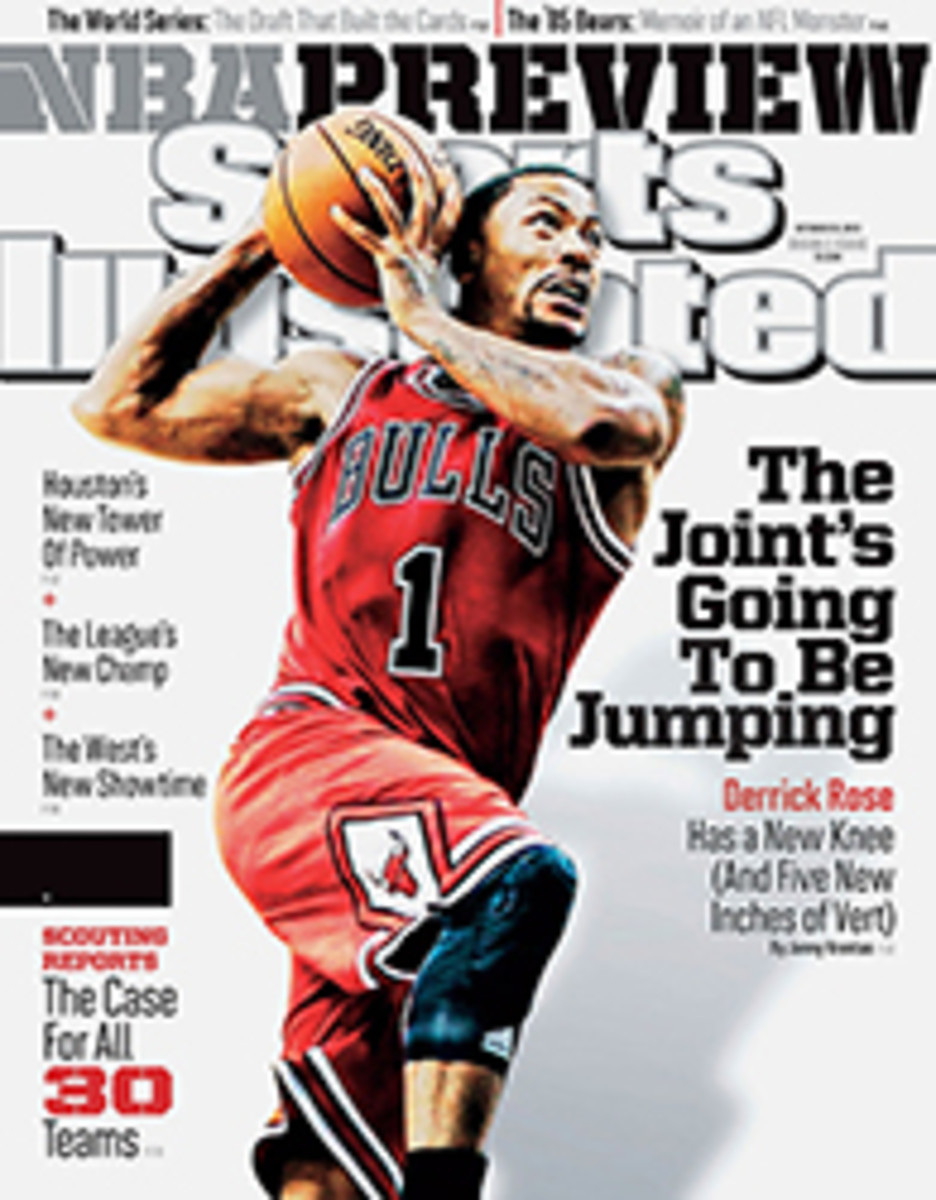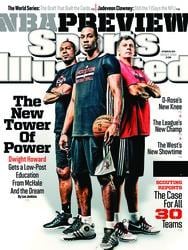
DERRICK ROSE'S NEW KNEE THIS JOINT IS JUMPIN'
You know the move: The nimble floor general is driving hard with the basketball. Then, in a split second, he dribbles across his body and bursts the opposite way. The defender is juked, his feet tripping over each other. The ankle-breaker. For the point guard, however, it's also a potential knee-breaker. The anterior cruciate ligament, the strip of connective tissue that runs diagonally between the thigh bone and the shin bone, stabilizes the knee. But cutting, or pivoting, or vaulting, or stopping on a dime to drop a dime, can in the worst-case scenario apply enough force to shred it.
An ACL tear is the reason 2011 MVP Derrick Rose hasn't played since a Bulls first-round playoff game in April 2012. He's among a trio of the league's top point guards who are coming back from knee surgeries: Boston's Rajon Rondo, also with a torn ACL, and Oklahoma City's Russell Westbrook, after a meniscus injury. Two other starting guards, Ricky Rubio of the Timberwolves and Iman Shumpert of the Knicks, had ACL surgery as rookies in 2012.
Does this say something about the strain of playing such a demanding position in the modern NBA—especially given that all of the aforementioned players except Rondo are 25 or younger? Or is it simply a run of bad luck? The answer is probably a little of both.
According to a 2010 article in the Sports Health journal that tracked the league's injuries through a 17-year period, no other body part causes more missed games in the NBA than the knee. As players continue to get bigger with each passing season, and as the game has become more acrobatic, their bigger and stronger bodies place a greater strain on the knee as they twist and turn and jump. This applies to ACL injuries as well as tears to the meniscus, the C-shaped piece of cartilage in the knee joint. "It's quite possible that their ability to generate power and torque has increased much more than the knee's ability to withstand these forces," says Neal ElAttrache, orthopedic surgeon at Kerlan-Jobe Orthopaedic Clinic in Los Angeles and consultant to several pro sports teams, including the Lakers.
ACL tears are on the rise across sport, gender, age and skill level. From 1985 to 2012 the number of ACL tears in the NBA has trended upward. Since 1992, there has been at least one ACL tear in each season—but never more than six (chart, previous page) according to a 2013 long-term study of injury in the NBA published in Sports Health. "There haven't been so many that it is an epidemic," says David Altchek, orthopedic surgeon at New York City's Hospital for Special Surgery and a medical consultant for the NBA. "I think we just had a blip on the radar screen. But we'll see."
One tactic to compensate for the strain today's generation of basketball players place on their knees is to better protect the joint by strengthening the surrounding muscles. Movement labs and functional movement specialists have become part of top athletes' post-knee-surgery rehabilitation, with the goal of reinforcing and balancing the body better than before the injury.
We hear this a lot: athletes proclaiming they are in better physical condition after ACL reconstructive surgery than before. After his first game in about 17 months, a preseason win against the Pacers on Oct. 5 in which he played 20 minutes, Rose told reporters he's added about five inches to his vertical jump. But returning to play at a top level is another matter.
Each player follows his own time line back to the court, which in Rose's case has drawn much scrutiny. Despite being cleared by doctors last March, Rose sat out the 2012--13 season, including the playoffs (in which the Bulls went out to the Heat in the second round). Rondo, who suffered a partial ACL tear in January, says he'll return once he has complete trust in his right knee, with an eye toward December. Westbrook had surgery to repair a meniscus tear in April but is expected to miss the first four to six weeks of the season after needing a second procedure earlier this month. Rubio and Shumpert each made it back in about nine months.
One hurdle to returning to preinjury form is restoring something called proprioception, the body's perception of its movement and orientation in space from sensory receptors in muscles and joints. Rebuilding this takes longer after an ACL tear than after a meniscus injury, since more of the knee tissue is damaged, and ElAttrache says it may also require more time in longer-bodied basketball players than in other athletes. A deficiency of this position sense might be a factor as to why a player like Rose could be medically cleared but still not feel "right" to return.
NBA players recovering from knee surgeries face unique demands, including an 82-game season; a sustained pace with dozens of sharp, abrupt movements; up to 12 minutes per quarter; and little margin for error in the essential skill of shooting. Returning to the court after knee surgery may take longer in the NBA than in other professional sports, like the NFL, where last year Minnesota's Adrian Peterson embarked upon a 2,000-yard season less than nine months after tearing his ACL. "Basketball is more of a perfection sport, so it is harder to mask little, subtle weaknesses that you might be able to in football," Altchek says.
The 2013 Sports Health study found that there is a high rate of return to the NBA for players after ACL surgery: 86% (though the number is lower, 71%, among guards). And when they do make it back, 30 years of statistics on NBA players show a noticeable drop-off in number of games played; minutes, points and rebounds per game; and field goal percentage in careers after ACL surgery. But the performance decline was not significantly different from a control group that had not had ACL surgery. (For instance, the group of players who underwent surgery saw their scoring drop from 10.3 points per game before surgery to 7.9; the control group's dropped from 10.3 to 7.5.) Indeed, Shumpert and Rubio saw their numbers virtually unchanged when they came back (chart, above), which bodes well for Rose, Rondo and Westbrook on their returns. Whenever they may be.
TEARING IT UP
AS THEY ARE IN OTHER SPORTS, ACL INJURIES ARE TRENDING UPWARD IN THE NBA
REGULAR-SEASON ACL TEARS
[The following text appears within a chart. Please see hardcopy or PDF for actual chart.]
0 1 2 3 4 5 6 7 8
1985
1987
1989
1991
1993
1995
1997
1999
2001
2003
2005
2007
2009
2011
DATA COURTESY OF SPORTS HEALTH: A MULTIDISCIPLINARY APPROACH
COMEBACK KIDS
ALTHOUGH IMAN SHUMPERT AND RICKY RUBIO WERE RUSTY WHEN THEY RETURNED FROM THEIR ACL TEARS LAST YEAR, THEY BOTH PUT UP NUMBERS THAT WERE IN LINE WITH THEIR PREINJURY STATS.
SHUMPERT
(Injured April 28, 2012, returned Jan. 17, 2013)
CHART

